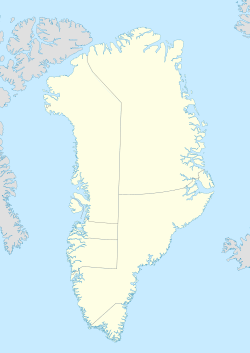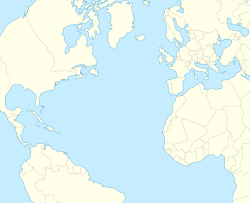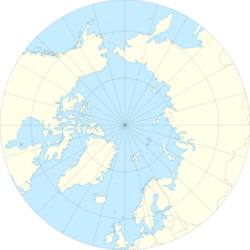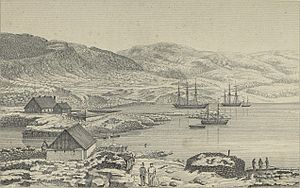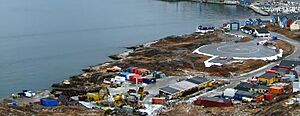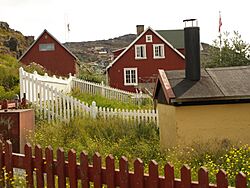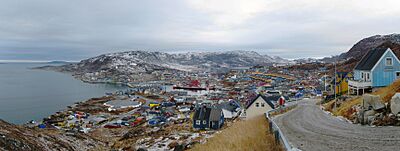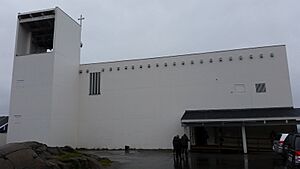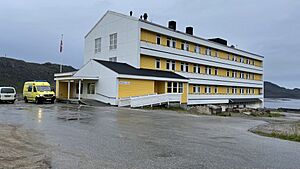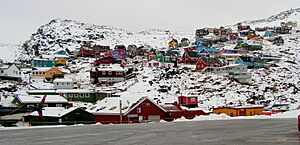Qaqortoq facts for kids
Quick facts for kids
Qaqortoq
Julianehåb
|
|||
|---|---|---|---|
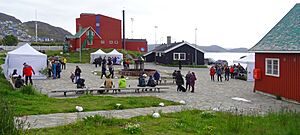
Qaqortoq market square
|
|||
|
|||
| Sovereign state | |||
| Constituent country | |||
| Municipality | |||
| Founded | 1774 | ||
| Population
(2020)
|
|||
| • Total | 3,050 | ||
| Time zone | UTC−02:00 (Western Greenland Time) | ||
| • Summer (DST) | UTC−01:00 (Western Greenland Summer Time) | ||
| Postal code |
3920
|
||
| Website | qaqortoq.gl | ||
Qaqortoq (which sounds like "qa-qor-tok") is a cool city in southern Greenland. It's also known as Julianehåb. This city is the capital of the Kujalleq area.
In 2020, about 3,050 people lived there. This makes Qaqortoq the biggest town in southern Greenland. It's also one of the largest towns on the whole island.
Contents
History of Qaqortoq
People have lived in the Qaqortoq area for a very long time. Humans have been here for about 4,300 years!
Early Cultures
The first people to live here were from the Saqqaq culture. They arrived around 4,300 years ago. We don't find as many Saqqaq items here as in other parts of Greenland. But we do find tools like stone drills and carving knives.
Later, the Dorset culture arrived about 2,800 years ago. They built rectangular homes made from peat (a type of soil). You can still find signs of these homes around Qaqortoq.
Norse Settlers
Around the late 900s, people from Norway and Iceland came to Greenland. They were called the Norse. You can see the ruins of their old buildings at Hvalsey, which is about 19 kilometers (12 miles) from Qaqortoq.
The Norse traded with people in northern Europe. They often traded ivory from walrus tusks. The Norse lived here for almost 500 years. Their time in Greenland ended in the mid-1400s.
Thule People
The Thule people were Inuit. They came to southern Greenland and the Qaqortoq area around the 1100s. They lived at the same time as the Norse. The Thule people lived by hunting and fishing. They didn't build many big homes, but we find many of their tools and items.
Modern Qaqortoq Begins
The town we see today was started in 1775. A trader named Anders Olsen from Denmark-Norway founded it. He named it Julianehaab after the Danish queen Juliane Marie.
Qaqortoq became a big center for trading saddle-back seal skins. Even today, the Great Greenland sealskin tannery is located here. It's a place where they process animal skins.
Until 2008, Qaqortoq was its own municipality. But on January 1, 2009, it became the main town of the larger Kujalleq municipality. This happened when three smaller towns in South Greenland joined together.
Cool Places to See
Old Buildings
The building that is now the Qaqortoq Museum used to be the town's blacksmith shop. It was built in 1804 from yellow stone.
The oldest building in Qaqortoq is at the old harbor. It's a black wooden building from 1797. It was designed in Denmark, shipped in pieces, and then put together here.
Stone & Man Art Project
Qaqortoq is known for its artists. From 1993 to 1994, a local artist named Aka Høegh worked with 18 other artists. They created the Stone & Man project.
Their goal was to turn the town into an outdoor art gallery. They carved 24 sculptures into rocks and boulders around the town. Today, there are over 40 sculptures from this project!
The Fountain
Qaqortoq has the oldest fountain in Greenland, called Mindebrønden. It was finished in 1932. For a long time, it was the only fountain in the country. The fountain shows whales spouting water from their blowholes. It's a popular spot for tourists.
Getting Around
Air Travel
Qaqortoq has a heliport, which is like a small airport for helicopters. Helicopters fly all year round. They connect Qaqortoq to Narsarsuaq Airport, which is about 60 kilometers (37 miles) away. From Narsarsuaq, you can fly to other parts of Greenland and Europe.
For many years, people talked about building a bigger airport for planes. A new airport with a 1,500-meter (4,921-foot) runway is being built. This will allow smaller jets to land, especially during the busy summer tourist season. A construction company from Canada signed a contract in February 2022. The airport is expected to be finished in 2025. This new airport is located about 5 kilometers (3 miles) north of the town.
Land Travel
Like most places in Greenland, Qaqortoq is not connected to other towns by roads. You can find hiking trails outside the town. For motorized travel, people use ATVs. In winter, snowmobiles are popular.
Since there are no other towns nearby by land, boats are the main way to travel in Greenland.
Sea Travel
Qaqortoq is a port where the Arctic Umiaq ferry stops. This ferry travels along the coast of Greenland. The port is deep enough for large ships, up to 500 feet (152 meters) long.
The port of Qaqortoq is a very important stop for cruise ships. Many large cruise ships visit each season, especially in late summer and early autumn. They often travel from northern Europe to the Caribbean.
Economy and Life in Qaqortoq
Qaqortoq is a busy seaport and a main center for southern Greenland. The economy here relies on several things. These include processing fish, tourism, tanning animal skins, making fur products, and repairing ships.
However, the main jobs are in education and government services. The Great Greenland Furhouse is the only tannery in Greenland. It buys most of the sealskins on the island and is a big employer in the town.
Farming is also important in the areas around Qaqortoq. People raise sheep, cattle, and reindeer. Qaqortoq provides services and supplies for these farms.
Jobs
In the summer of 2020, about 7% of people in Qaqortoq were looking for jobs. This number has been going down over the last ten years.
Electricity
All of Qaqortoq's electricity comes from a company called Nukissiorfiit. Since 2007, most of the town's power comes from the Qorlortorsuaq Dam. This dam is about 70 kilometers (43 miles) away. Before that, the town used diesel generators for electricity.
Education
Qaqortoq is a major place for education in southern Greenland. It has schools for all ages: a primary school, a middle school, and a high school. There's also a folk high school, a business school, and a vocational school for learning job skills.
Religion
Gertrud Rasch's Church
Gertrud Rasch's Church is a white church made of concrete. It's named after Gertrud Rask, who was the wife of a famous missionary named Hans Egede. The old church in Qaqortoq became too small as the town grew. So, a new church was built.
Construction started in May 1972, and it was opened on July 8, 1973. The church was designed by Ole Nielsen. Inside, the altar is also made of concrete. The artwork behind the altar shows plants from southern Greenland. The church also has a special organ from 1973.
Healthcare
Qaqortoq has a hospital called Napparsimavik Hospital. It's the main hospital for all of southern Greenland. It has 18 beds and a staff of 59 people. The hospital also helps people in three nearby villages: Eqalugaarsuit, Saarloq, and Qassimiut. They visit these villages by boat or use a helicopter for emergencies.
Tourism
Tourism is a big part of Qaqortoq's economy. The Qaqortoq Tourist Service helps visitors. Qaqortoq is the main place for cruise ships to stop in Greenland. More than 35 cruise ships visit each season, bringing over 30,000 visitors. Many tourists come from Germany, Britain, and the United States.
Most non-cruise tourists (about two-thirds) are from Denmark. There are places to stay, like the Qaqortoq Hostel. The Qaqortoq Museum offers tours in English, Danish, and Kalaallisut (the Greenlandic language). The Great Greenland Furhouse is also a popular place to visit.
Tourists can enjoy activities like kayaking, hiking with guides, and whale-watching. They can also take tours to see the Greenland ice cap, old Norse ruins, farms, and the Uunartoq hot springs.
Qaqortoq has the first artificial grass football stadium in Greenland, called the Qaqortoq Stadium. In 2014, the Danish Crown Prince family visited the town. They even planted a small group of poplar trees.
Population Changes
Qaqortoq had 3,050 people living there in 2020. The population has gone down by about 500 people since the early 2000s.
There are about the same number of men and women among people born in Greenland. But among people born outside Greenland, more men live here. In 2011, about 10% of the town's people were born outside Greenland.

Geography and Climate
Qaqortoq is located in the Qaqortoq Fjord, right next to the Labrador Sea.
Weather in Qaqortoq
Qaqortoq has a polar climate, but it's influenced by the ocean. This means it has cold, snowy winters and cool summers. Unlike many places far north, Qaqortoq doesn't have permafrost (ground that is always frozen).
Because it's a bit warmer than other towns, some small groups of trees can actually grow here! This is rare for Greenland. The ocean helps keep the weather from changing too much between seasons.
| Climate data for Qaqortoq, Greenland (57 m asl, normals 1991–2020, extremes 1961–2020) | |||||||||||||
|---|---|---|---|---|---|---|---|---|---|---|---|---|---|
| Month | Jan | Feb | Mar | Apr | May | Jun | Jul | Aug | Sep | Oct | Nov | Dec | Year |
| Record high °C (°F) | 12.3 (54.1) |
12.0 (53.6) |
12.5 (54.5) |
14.0 (57.2) |
21.8 (71.2) |
20.0 (68.0) |
21.7 (71.1) |
23.0 (73.4) |
21.6 (70.9) |
17.8 (64.0) |
13.7 (56.7) |
12.0 (53.6) |
23.0 (73.4) |
| Mean daily maximum °C (°F) | −1.9 (28.6) |
−2.5 (27.5) |
−1.1 (30.0) |
3.4 (38.1) |
6.7 (44.1) |
9.8 (49.6) |
11.7 (53.1) |
11.2 (52.2) |
8.7 (47.7) |
4.8 (40.6) |
0.9 (33.6) |
−1.0 (30.2) |
4.2 (39.6) |
| Daily mean °C (°F) | −4.9 (23.2) |
−5.5 (22.1) |
−4.1 (24.6) |
0.4 (32.7) |
3.4 (38.1) |
6.2 (43.2) |
8.1 (46.6) |
8.1 (46.6) |
5.9 (42.6) |
2.3 (36.1) |
−1.7 (28.9) |
−3.7 (25.3) |
1.2 (34.2) |
| Mean daily minimum °C (°F) | −7.8 (18.0) |
−8.6 (16.5) |
−7.4 (18.7) |
−2.7 (27.1) |
0.2 (32.4) |
2.7 (36.9) |
4.6 (40.3) |
5.3 (41.5) |
3.5 (38.3) |
−0.1 (31.8) |
−4.0 (24.8) |
−6.4 (20.5) |
−1.7 (28.9) |
| Record low °C (°F) | −30.0 (−22.0) |
−25.2 (−13.4) |
−26.0 (−14.8) |
−16.4 (2.5) |
−12.8 (9.0) |
−6.0 (21.2) |
−2.4 (27.7) |
−3.4 (25.9) |
−8.5 (16.7) |
−11.0 (12.2) |
−18.0 (−0.4) |
−21.6 (−6.9) |
−30.0 (−22.0) |
| Average precipitation mm (inches) | 75.6 (2.98) |
77.7 (3.06) |
63.8 (2.51) |
66.7 (2.63) |
58.3 (2.30) |
69.3 (2.73) |
81.6 (3.21) |
103.0 (4.06) |
116.2 (4.57) |
88.8 (3.50) |
100.6 (3.96) |
70.1 (2.76) |
971.7 (38.27) |
| Average precipitation days (≥ 1 mm) | 10.2 | 9.5 | 8.3 | 7.2 | 7.3 | 8.4 | 8.4 | 9.9 | 11.1 | 8.7 | 9.6 | 9.3 | 107.9 |
| Average relative humidity (%) | 66.5 | 67.8 | 65.8 | 70.7 | 75.8 | 79.7 | 81.8 | 84.9 | 77.8 | 67.5 | 72.6 | 70.1 | 73.4 |
| Source: Danish Meteorological Institute; raw data (humidity 2004–17) | |||||||||||||
Sister City
Qaqortoq is connected to another city far away:
 Aarhus, Denmark
Aarhus, Denmark
International Connections
Qaqortoq has a special office called a consulate from the country of Latvia. This office helps represent Latvia in Greenland.
See also
 In Spanish: Qaqortoq para niños
In Spanish: Qaqortoq para niños




